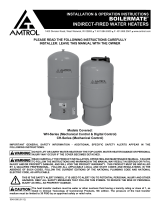4 5
Water is not
compressible
Since water completely
fills the water heater
and system piping before
recovery starts, and since
it can't be compressed,
the expanded volume,
even though small, has no
place to go.
As a result, the expanding
water creates a rapid
and dangerous pressure
increase in the water
heater and system piping,
much like the action of a
hydraulic ram.
So "pop" goes the relief valve
The setting on a temper-
ature & pressure safety
relief is quickly reached,
and the relief valve
opens, losing heater
water down the drain or,
more often than not, all
over the floor.
The illogical practice of operating your safety valve
once or twice a day is not only wasteful (you paid to
heat the water that went down the drain), it's also
dangerous.
First of all, the T & P
relief valve you
installed serves as
an emergency con-
trol only. It was never
designed as an
operating control.
Once a safety valve
is used on a daily
basis, it isn't that
safe.
Deposits on the seat... deteriorating springs... wear-
and-tear erosion can wear out a relief valve in no time
at all.
Dangerous
pressures
before relief
What most
people don't
realize is that
dangerous
conditions can exist during thermal expansion long
before the relief valve operates.
Internal pressures repeatedly occurring during recovery
periods can collapse the center flue of a gas-fired water
heater, creating a hazardous presence of deadly carbon
monoxide gas, or even a water-heater explosion.








